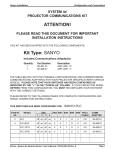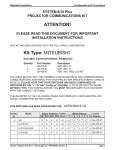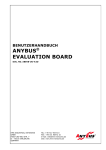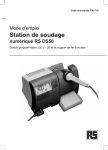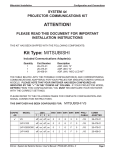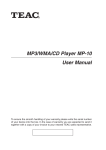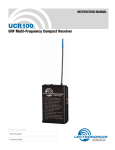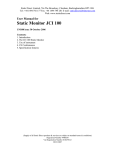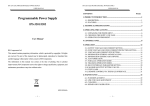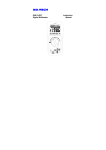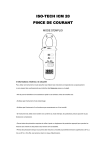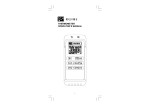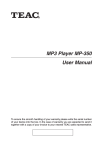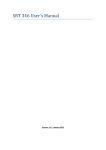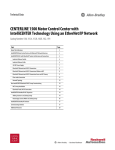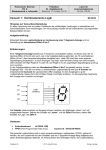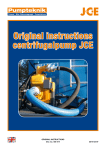Download user manual anybus®ic evaluation board
Transcript
USER MANUAL ANYBUS®IC EVALUATION BOARD DOC. NO. ABSICEVB-UM-1.01E HMS INDUSTRIAL NETWORKS GMBH HAID-UND-NEU STR. 7 D – 76316 KARLSRUHE GERMANY TEL: +49 721 96472 0 FAX: +49 721 96472 10 e-mail: [email protected] web: www.hms-networks.de ® ANYBUS-IC EVALUATION BOARD User Manual Version 1.01e 2004-05-11 Revision Notes Index Date Chapter Autor Revision Revision note 1 2 2003-05-01 2003-10-21 All 5.2 Mat Mat 1.0 1.01 Build Tolerance for power supply updated Preface This document describes the technical features and usage of the AnyBus-IC Evaluation Board. The Evaluation Board allows you to set up a complete development environment for creating applications which use the AnyBus-IC Module with serial interface. ! Please refer to the appendix for a list of supported AnyBus-IC modules. The information and illustrations in this document are not binding. HMS reserves the right to make modifications and changes if necessary. HMS is not responsible for errors which are caused by incorrect information in this document. AnyBus® is a registered trademark of HMS Industrial Networks AB. Proprietary names and trademarks in this document are protected by law and belong to the respective owners. HMS INDUSTRIAL NETWORKS GMBH 2 ANYBUS-IC EVALUATION BOARD User Manual Version 1.01e 2004-05-11 Table of contents Revision Notes ...................................................................................................................................................................2 Preface................................................................................................................................................................................2 Table of contents ...............................................................................................................................................................3 1. Introduction...............................................................................................................................................................4 1.1 Scope of delivery ................................................................................................................................................4 1.2 System requirements ...........................................................................................................................................4 1.3 Related documents ..............................................................................................................................................4 2. Hardware description ...............................................................................................................................................5 2.1.1 AnyBus-IC Evaluation Board external........................................................................................................5 2.1.2 AnyBus-IC Evaluation Board Circuit Diagram ..........................................................................................6 2.1.3 AnyBus-IC Evaluation Board Fieldbus Boards...........................................................................................7 2.2 Connectors ..........................................................................................................................................................8 2.2.1 Power supply...............................................................................................................................................8 2.2.2 MIF Interface (Hardware) ...........................................................................................................................8 2.2.3 SCI Interface RS232 (Hardware) ................................................................................................................8 2.2.4 SCI Interface TTL (Hardware)....................................................................................................................9 2.2.5 SSC Onboard Interface (Hardware) ............................................................................................................9 2.2.6 SSC expansion Interface (Hardware) ........................................................................................................10 2.2.7 AnyBus-IC DIL 32 Socket........................................................................................................................11 2.2.8 LEDs .........................................................................................................................................................12 2.2.9 Switches ....................................................................................................................................................13 2.2.10 Potentiometer ............................................................................................................................................14 2.2.11 Display ......................................................................................................................................................14 2.2.12 Reset Switch / SCI DE Jumper..................................................................................................................15 3. Simple StartUp ........................................................................................................................................................16 4. Master for fieldbus systems....................................................................................................................................17 5. Appendices...............................................................................................................................................................18 5.1 Sample Code .....................................................................................................................................................18 5.2 Technical Data ..................................................................................................................................................18 5.3 Abbreviations ....................................................................................................................................................19 5.4 Supported AnyBus-IC module types.................................................................................................................20 5.5 Recommended connector & accessory manufactures .......................................................................................21 Shift Registers...........................................................................................................................................................21 Power supply connector ............................................................................................................................................21 Power Supply ............................................................................................................................................................21 HMS INDUSTRIAL NETWORKS GMBH 3 ANYBUS-IC EVALUATION BOARD User Manual Version 1.01e 2004-05-11 1. Introduction This document will show the technical background of the connection between AnyBus IC and AnyBus IC Evaluation Board. It’s strongly recommended to read chapter 3 “Simple StartUp” before using the AnyBus IC Evaluation Board. Please contact our technical support department if you have any technical questions. Please refer to the end of the appendix of this document for the address. The appendix also contains a feedback form which you should use if you have any suggestions for improving this product. 1.1 Scope of delivery Designation Description AnyBus-IC Evaluation Board Development board for inserting an AnyBus-IC module. The board contains all needed parts to communicate between a fieldbus system like Profibus, DeviceNet or Industrial Ethernet and a serial connection with RS232 or direct communication to I/O signal lines with shift registers. 1 Serial 1:1 cable D-SUB9 socket <–> D-SUB9 plug 3 Fieldbus Adapter Boards Adapter Boards with typical fieldbus connectors for connection to Profibus, Devicenet and Ethernet AnyBus-IC Tools CD-ROM Contains: AnyBus-IC User Manual Example software AnyBus-IC Design Guides, Fieldbus Appendix, technical drawings Freeware Modbus/TCP Server 1.2 System requirements Part Requirement IBM Compatible PC min. Pentium I Operating System Windows 9X,ME,NT,2K, DOS, LINUX Programm Standard Terminal Programm (Hyperterm…) Power Supply 5V DC, 800mA AnyBus Fieldbus Module AnyBus-IC for Profibus, DeviceNet or Industrial Ethernet 100 MHz, 32MB RAM, free RS232 Port with D-SUB9 1.3 Related documents Name Description Document Number AnyBus-IC Design Guide General Engineering information for In-Design of AnyBus-IC ABS-DESIGN-SER AnyBus-IC Appendix - Profibus Data sheet for AnyBus-S Profibus-DP ABS-APPENDIX-PDP AnyBus-IC Appendix - DeviceNet Data sheet for AnyBus-S DeviceNet ABS-APPENDIX-DEV AnyBus-IC Appendix - Ethernet Data sheet for AnyBus-S Ethernet ABS-APPENDIX-ETN HMS INDUSTRIAL NETWORKS GMBH 4 ANYBUS-IC EVALUATION BOARD User Manual Version 1.01e 2004-05-11 2. Hardware description 2.1.1 AnyBus-IC Evaluation Board external 14 15 16 1 2 3 4 5 6 13 7 8 Figure 1: AnyBus-IC Evaluation Board 12 11 10 9 1. Potentiometer for Analogue value (Input Byte #2) 2. Digital switch for binary input values (Input Byte #1) 3. Digital switch for binary input values/ Address switch (Input Byte #0) 4. SCI DE Jumper to enable SCI communication/Reset switch 5. Mounting screws for fieldbus connector 6. Interface for fieldbus boards 7. Socket for Fieldbus connector 8. AnyBus IC 9. LEDs for digital output/Diagnosis LED (Output Byte #0) 10. LEDs for digital output (Output Byte #1) 11. Digital display for analogue output values (Output Byte #2) 12. Power supply connector (5V DC, 800 mA) 13. MIF interface connector (RS232) 14. SCI interface connector (RS232) 15. SCI interface connector (5V TTL) 16. SSC Expansion connectors HMS INDUSTRIAL NETWORKS GMBH 5 ANYBUS-IC EVALUATION BOARD User Manual Version 1.01e 2004-05-11 2.1.2 AnyBus-IC Evaluation Board Circuit Diagram Figure 2: Schematic of AnyBus IC Evauation Board HMS INDUSTRIAL NETWORKS GMBH 6 ANYBUS-IC EVALUATION BOARD User Manual Version 1.01e 2004-05-11 2.1.3 AnyBus-IC Evaluation Board Fieldbus Boards Figure 3: Schematic of Fieldbus connector boards HMS INDUSTRIAL NETWORKS GMBH 7 ANYBUS-IC EVALUATION BOARD User Manual Version 1.01e 2004-05-11 2.2 Connectors 2.2.1 Power supply The Evaluation Board must be connected to an external 5V/800mA power supply using a plugable screw connector. Note that there is no over voltage protection implemented. | + GND +5V Evaluation Board Top View Figure 4: Power supply connector front view Figure 5: Position of power supply connector 2.2.2 MIF Interface (Hardware) A PC is required to monitor and configure the AnyBus IC over the MIF Interface. See chapter 4 in the AnyBus-IC Design Guide for more information regarding the terminal program. The serial interface of the Evaluation Board is connected directly to a serial interface of an IBM compatible PC (COM1 – COMX) using the supplied cable. The RS232 interface already has crossed over Tx and Rx lines and thus the connection is made with a 1:1 cable. The following pins are used: 1. RxD (Pin 2) 2. TxD (Pin 3) 3. GND (Pin 5) Figure 6: Front view of D-SUB 9 female PC connector 2.2.3 SCI Interface RS232 (Hardware) A PC or other RS232 Device is required to communicate to the AnyBus IC over the SCI RS232 Interface. See chapter 3 to learn more about the used ModbusRTU protocol. The serial interface of the Evaluation Board is connected directly to a serial interface of an IBM compatible PC (COM1 – COMX) using the supplied cable. The RS232 interface already has crossed over Tx and Rx lines and thus the connection is made with a 1:1 cable to the PC’s COM-port. The following pins are used: 1. RxD (Pin 2) 2. TxD (Pin 3) 3. GND (Pin 5) Figure 7: Frontview of D-SUB 9 female PC connector HMS INDUSTRIAL NETWORKS GMBH 8 ANYBUS-IC EVALUATION BOARD User Manual Version 1.01e 2004-05-11 2.2.4 SCI Interface TTL (Hardware) A micro controller or other serial device with UART can communicate to the AnyBus IC over the SCI-TTL Interface. See chapter 3 to learn more about the used Modbus protocol. The difference between this and the SCI RS232 interface is the missing RS232 physics. Only 5V TTL based voltage level is used. 1. TxD (Pin 1) 2. RxD (Pin 2) 3. GND (Pin 3) Figure 8: SCI TTL based connector 1 2 3 2.2.5 SSC Onboard Interface (Hardware) The ABIC Evaluation Board has a fixed amount of mounted shift registers. These are 3 shift registers (3 byte) for Input and 3 shift registers (3 byte) for Output. If the auto configuration is used, the registers have the following functions: Input Register Nr. Meaning Output Register Nr. Meaning 1 Address setting 1 Status LEDs 2 Digital Input 2 Digital Output 3 Analogue Input 3 Analogue Output If the auto config is not used, the first shift registers for input and output can also configured as digital Input/Output. Please note that the output byte one is made with revers bi-colour LEDs. Thus pair bit combinations are not possible. See chapter 2-6 in the AnyBus-IC Design Guide. Hex-Value Binary-Bit combination Visualisation 0xAA 10101010 Yes, all pairs different: red 0x55 01010101 Yes, all pairs different: green 0x33 00110011 No, all pairs identical 0xFF 11111111 No, all pairs identical 0x78 01111000 No for the identical pair combination L1+L3, Yes for the different combination L2+L4 HMS INDUSTRIAL NETWORKS GMBH 9 ANYBUS-IC EVALUATION BOARD User Manual Version 1.01e 2004-05-11 2.2.6 SSC expansion Interface (Hardware) Additional shift registers can be used to expand the amount of I/O data over SSC interface. The additional shift registers can be mounted on a separate PCB connect to the SSC expansion interface. Please note that air wires may cause EMC problems and act as antenna. JP6 is connected to all shift registers for load, reset and clock signal. JP 5 and JP 6 should be short circuit by jumper if no external shift registers are connected. JP 5 is the serial connection for expanded input shift registers. Same for JP 4 as output expansion. No Additional Shift Registers JP4 Additional Shift Registers JP5 JP4 Input Output Input Shiftregister Output Shiftregister AB IC Output Output Shiftregister SSC DI 1 Output Output Shiftregister SSC DI 1 Input Additional Input Shiftregiste Input Input Shiftregister AB IC Input Input Shiftregister Figure 10: No additional shift registers Output Output Shiftregister Input Input Shiftregister Figure 9: Additional Input shift registers The SSC Interface connectors are used to expand the onboard mounted shift registers with additional external shift registers. Please note that air wires may cause EMC problems and act as an antenna. Figure 11: Position of SSC external connection JP6 will extend the LD, CLK and RST lines. See chapter 226 for more information. JP4 and JP5 will extend the shift register line for Input (JP4) and Output(JP5). Open the short circuit jumper and insert up to 14 8 Bit shift register devices to extend to the maximum size of 128 Bit I/O data. HMS INDUSTRIAL NETWORKS GMBH 10 ANYBUS-IC EVALUATION BOARD User Manual Version 1.01e 2004-05-11 2.2.7 AnyBus-IC DIL 32 Socket The AnyBus-IC DIL 32 Socket at the Evaluation Board is used to plug in the AnyBus-IC module. The pin assignments are shown in following table: Figure 12: Position of AnyBus-IC DIL Socket Pin Name Description 1 Vcc +5V Power Supply 2 SSC Reset Out SSC Reset signal to shift registers 3 SSC LD SSC Load signal to shift registers 4 SSC DO SSC Data output signal to shift registers 5 SSC DI2 SSC Data input 2 signal from shift registers 6 SSC DI1 SSC Data input 1 signal from shift registers 7 SSC CLK SSC Clock signal for shift registers 8 Reset Reset signal 9 Vcc +5V Power Supply 10 - 12 NC Not connected 13 - 16 FB1 – FB4 Fieldbus specific signals line 1-4 17 PE Protective earth 18 Shield Fieldbus shield 19 - 20 FB5 – FB6 Fieldbus specific signals line 5-6 21 - 23 NC Not connected 24 GND Ground Power Supply 25 NC Not connected 26 INT/BLE Interrupt / Bootloader enable 27 MIF Tx MIF transmit signal 28 MIF Rx MIF receive signal 29 SCI DE SCI DE signal 30 SCI Tx SCI transmit signal 31 SCI Rx SCI receive signal 32 GND Ground Power Supply HMS INDUSTRIAL NETWORKS GMBH 11 ANYBUS-IC EVALUATION BOARD User Manual Version 1.01e 2004-05-11 2.2.8 LEDs The Evaluation Board is provided with the following status diagnostic or data LEDs: The power LED indicates that the 5V DC power supply is present. The MIF communication LED TxD flashes when data is being sent to the PC. The LED RxD flashes when data is received from the PC. The LED SCI TxD flashes when data is being sent to the ModbusRTU Master. The LED RxD flashes when data is being received from the ModbusRTU Master. These LEDs are only for diagnostic purposes and cannot be controlled by your program. SCI communication LEDs Figure 14: Position of communication LEDs MIF communication LEDs Digital Data LEDs Diagnostics/Data LEDs Power LED Figure 13: Position of Diagnosis LEDs The Digital Output Byte0, Byte 1 LEDs are used to show the digital status of the first two bytes, sent from the ABIC to the shift registers. Byte 1 is made with 8 green LEDs. Each byte is representing one bit in the first data byte. Byte0 is made with four bi-color LEDs. Because of the Bi-Color LEDs at Output Byte 0 and its pre-defined function as Fieldbus Status diagnosis its not possible to transmit all possible data states to this LEDs. Only different binary values for bit-pair combinations will show a light: L4 00 11 01 10 nv nv green red L3 00 11 01 10 nv nv green red L2 00 11 01 10 nv nv green red L1 00 11 01 10 nv nv green red *nv=no visualisation HMS INDUSTRIAL NETWORKS GMBH 12 ANYBUS-IC EVALUATION BOARD User Manual Version 1.01e 2004-05-11 The reason is that 00 or 11 will cause a 0V-0V or 5V-5V connection to the LED. A Bi-Color LED needs a 0V-5V for lighting in green color or 5V-0V connection to light in red color. 2.2.9 Switches The Evaluation Board is provided with two micro switches as follows: Designation Description Input Byte 0 First data Byte. In “Only SSC Mode” this is used as address or address/baudrate switch. LSB is right Input Byte 1 Second data byte. In “Only SSC Mode” this is used as first data byte Data/Address switch Data switch Input Shift register byte 1 Input Shift register byte 0 Figure 15: Position of switch buttons The switches are connected directly to the shift registers with internal pull down resistors. HMS INDUSTRIAL NETWORKS GMBH 13 ANYBUS-IC EVALUATION BOARD User Manual Version 1.01e 2004-05-11 2.2.10 Potentiometer The potentiometer on the Evaluation Board is used to provide an analog signal for generating user data for data transmission. The value set by the axis will demonstrate the incoming analog value that is converted by the A/D converter and moved with the shift register into byte 2. 8 Bit A/D Converter Input Shift register byte 2 Data Potentiometer Figure 16: Analog Input 2.2.11 Display The Display is used to show the byte 2 value as analog data. The data from ABIC transmitted to the shift register in output byte 2 is converted with the D/A converter into an 0-5V analog value. This value is connected to the display that will show its voltage value. 8 Bit Shift register byte 2 8 Bit D/A Converter Data Display Figure 17: Analog Output ! If necessary, you can remove the LCD from the Evaluation Board and connect it using a cable of length < 10cm. However, you will lose the manufacturer's guarantee if you do this. HMS INDUSTRIAL NETWORKS GMBH 14 ANYBUS-IC EVALUATION BOARD User Manual Version 1.01e 2004-05-11 2.2.12 Reset Switch / SCI DE Jumper (Only SSC Mode) The Evaluation Board is provided with a hardware reset switch. Using this switch will cause a hardware reset on the ABIC. Near the switch is the location for BL/SCI DE switch. BL- (BootLoader) switch is only used for Bootloader enabling function. Please see chapter 8-2 in AnyBus IC Design Guide. The BootLoader switch can be closed by using a jumper. Same pin pair (1-3) is also used for detecting Interrupt requests. Pin 1 is GND and Pin 3 is the IRQ line. The SCI DE switch is used for enabling the SCI communication interface. To enable the SCI-Interface the Jumper JP7 2-4 has to be removed. With short 2-4 pin the IC will detect the amount of shift registers and start automatically. Reset Switch Figure 18: Reset Switch/ Bootloader / Interrupt Boot loader Enable/ Interrupt Request HMS INDUSTRIAL NETWORKS GMBH SCI Data Enable 15 ANYBUS-IC EVALUATION BOARD User Manual Version 1.01e 2004-05-11 3. Simple StartUp • For a simple start up connection of the AnyBus IC it’s necessary to prepare the hardware and software configuration. Please follow the steps to achieve the first communication: • check the jumpers In a simple Startup 3 jumpers are needed: JP4;JP5 and JP7. JP4 and JP5 are used for closing the extended SSC connection. JP7 will disable the SCI interface. All other jumpers must left open. (see figure 11 and figure 18) • check the correct AnyBus IC connection Don’t connect the AnyBus-IC reversed to the socket. The HMS logo must be close to middle of the Evaluation Board (close to the capacitor C10, see figure 12) • Use the correct fieldbus connector Use the fieldbus connector that match to the fieldbus system: - 9 Pin SUB-D fieldbus connector together with AnyBus IC PDP - Grey plugable Screw fieldbus connector together with AnyBus IC DEV - RJ45 fieldbus connector together with AnyBus IC EIT/EIP Other combinations can harm the AnyBus IC! Worst combination is PDP or EIT/EIP IC together with Devicenet connector and connected 24V supply! This will destroy the AnyBus-IC! • Connect a PC to MIF Use the serial 1:1 cable to connect the EVB’s monitor interface (MIF) to a PC’s COM port. Start a terminal program like Microsoft’s Hyperterm with this settings: - 38400 kBaud - 8 databits - 1 stopbit - no parity - no flowcontrol • Connect power to the Evaluation Board We recommend to use a stabilized power supply with constant 5V±10% and a min. current of 800 mA . Connect the Plus polarity cable to the pin close to the SUB-D connector for MIF. Connect the ground polarity cable to the pin close to the lowest left corner. Please note that there is no over voltage protection implemented. Wrong voltage level or reversed power supply can harm the Evaluation board and the AnyBus IC. The board is powered if the power LED is lighting. The menu for the configuration will be generated an transferred to the terminal program. Depending on the fieldbus system the dual-LEDs at the first output byte will light. Also the first input byte delivered by the first DIP-switches is used as address setting. See chapter 2 at the ABIC fieldbus appendix. You can use now the ABIC-Evalboard as a fieldbus slave with two byte input and two byte output data. The first digital input data is “INPUT Byte 1” with DIP-switch and the first byte output is “OUTPUT Byte 1” with 8 green LEDs. The data for the second byte input is delivered by the potentiometer in “Input Byte 2” and the second byte output is shown at analogue values by the Display at “OUTPUT Byte 2”. You can use a master system or a master simulator to transmit data from/to the AnyBus IC Evaluationboard. Master simulators are available for Profibus-DP, Devicenet and ModbusTCP. HMS INDUSTRIAL NETWORKS GMBH 16 ANYBUS-IC EVALUATION BOARD User Manual Version 1.0e 2004-05-11 4. Master for fieldbus systems When developing and testing programs for AnyBus-S modules, a master is required for the respective bus system. In addition to standard SPS masters, HMS recommends the use of so-called master simulators. These are simple fieldbus master systems with small limitations which simulate bus communication with the respective fieldbus system and allow the exchange of data between master and slave. Master simulators are currently available for Profibus DP, Profibus DPV1, DeviceNet and Interbus- S. Figure 19: Profibus DP Master simulator The supplied HMS CD-ROM also includes a simple freeware Modbus/TCP Server which can be used to test communication between an AnyBus-S Ethernet module / AnyBus IC on the Evaluation Board and a PC. Please observe the installation instructions! Figure 24: Freeware Modbus/TCP Server ! The supplied Modbus/TCP Server Software is demonstration software which is freely available in the Internet. HMS cannot provide support for installation and commissioning. HMS INDUSTRIAL NETWORKS GMBH 17 ANYBUS-IC EVALUATION BOARD User Manual Version 1.0e 2004-05-11 5. Appendices 5.1 Sample Code The sample code is included at the AnyBus-Tools CD-Rom. Each program is prepared to run at the Keil C51 compiler environment and the AnyBus Evaluation Board. It is downloadable with the monitor functionality described in chapter 4.4 at the Evaluation Board user manual. For further questions and inspirations we have in the Club AnyBus an open ear for you any time . http://www.hms-networks.com/club_anybus/club_area.asp 5.2 Technical Data Measurement PCB Standard Euro Format: 160 mm x 100 mm Possible Case Phoenix Case UM100 125 mm x 162 mm Complete height with connected AnyBus IC app. 50 mm (depending from fieldbus type) Recommended Power Supply 5V regulated ±10% Tolerance ANYBUS-IC EVALUATION BOARD User Manual Version 1.0e 2004-05-11 5.3 Abbreviations Important abbreviations used in this manual: ABC ABS ACK DPRAM EVB; EvalBoard µC LED LSB MSB NAK NC PAR RO R/W SER TBD AnyBus ComAdapter AnyBus-S Acknowledge Dual-Port RAM AnyBus-S Evaluation Board Microcontroller (80XXX) Light Emitting Diode Least Significant Bit Most Significant Bit Negative Acknowledge Not Connected Parallel Interface Read Only Read / Write Serial Interface To Be Defined ANYBUS-IC EVALUATION BOARD User Manual Version 1.0e 2004-05-11 5.4 Supported AnyBus-IC module types The following AnyBus-S module types are suitable for use with the Evaluation Board. Special AnyBus-S module types are also supported (but see note below the table). Description Order Nr. Fieldbus Type ABIC-PDP AB6000 Profibus- DP ABIC-DEV AB6001 DeviceNET ABIC-EIT AB6002 10/100 Mbit/s ModbusTCP+IT Funct. ABIC-EIP AB6003 10/100 Mbit/s ModbusTCP+EthernetIP+IT Funct. ABIC-COP * * in preparation ANYBUS-IC EVALUATION BOARD User Manual Version 1.0e 2004-05-11 5.5 Recommended connector & accessory manufactures Shift Registers • 74AHCT594 • 74HCT165M Europe EBV EUROPEAN SERVICE Im Technologiepark 2-8 D-85586 Poing, Germany Tel.: +49 - 8121 - 774 - 0 Fax : +49 - 8121 - 774 - 422 Schweden EBV EUROPEAN SERVICE Derbyvägen 20 S-21235 Malmö, Sweden Tel.: +46 - 40 – 59 21 00 Fax : +46 - 40 – 59 21 01 Headquarter EBV EUROPEAN SERVICE Im Technologiepark 2-8 D-85586 Poing, Germany Tel.: +49 - 8121 - 774 - 0 Fax : +49 - 8121 - 774 - 422 Power supply connector . • 2 pins Europe Phoenix Contact GmbH & C0. Flachsmarktstraße 8 32825 Blomberg Tel.: +49 – 5235 – 300 Fax: +49 – 5235 – 341200 WEB: www.phoenixcontact.com • 2,54 mm grid Schweden Headquarter Phoenix Contact GmbH & C0. Flachsmarktstraße 8 32825 Blomberg Tel.: +49 – 5235 – 300 Fax: +49 – 5235 – 341200 WEB: www.phoenixcontact.com Power Supply . • Wide range power supply • 100 V-250 V Primary • 5V Secondary • Changeable connector for US,EU,JP... Europe RS Components GmbH Hessenring 13b 64546 Mörfelden-Walldorf Tel.: ++49 – 6105 – 401 – 234 Fax.: ++49 – 6105 – 401 – 100 WEB: www.rs-components.de Schweden RS Components AB Box 15 162 11 Vällingby Tel.: ++46 – 8 - 445 – 8900 Fax.: ++46 – 8 – 687 – 1152 WEB: www.rs-components.com Headquarter RS Components International PO Box 99, Corby, Northants NN17 9RS, United Kingdom Tel.: ++44 – 1536 – 201234 Fax.: ++44 – 1536 – 204237 WEB: www.rs-components.com ANYBUS-S EVALUATION BOARD User Manual Version 1.1 2004-05-11 If you have any comments about this documentation, please take a few minutes to fill out this form, and let us know about your opinions. These comments will help us improve our work, and make us aware of what customers of our products may find good, faulty or even missing. Document title:_____ ABSICEVB-UM 1.01E ___________ Revision: _____________________ _______________ Your name: _____________________________________________________ Company: _____________________________________________________ Phone: _____________________________________________________ E-mail: _____________________________________________________ Comments:____________________________________________________________________________ ______________________________________________________________________________________ ______________________________________________________________________________________ ______________________________________________________________________________________ ______________________________________________________________________________________ ______________________________________________________________________________________ ______________________________________________________________________________________ ______________________________________________________________________________________ ______________________________________________________________________________________ ______________________________________________________________________________________ Send your comments to: HMS Industrial Networks GMBH Haid-und-Neu Str.7 76131 Karlsruhe Germany You may also mail or fax your comments: E-mail: [email protected] Fax: +49 (0)271 96472 10






















